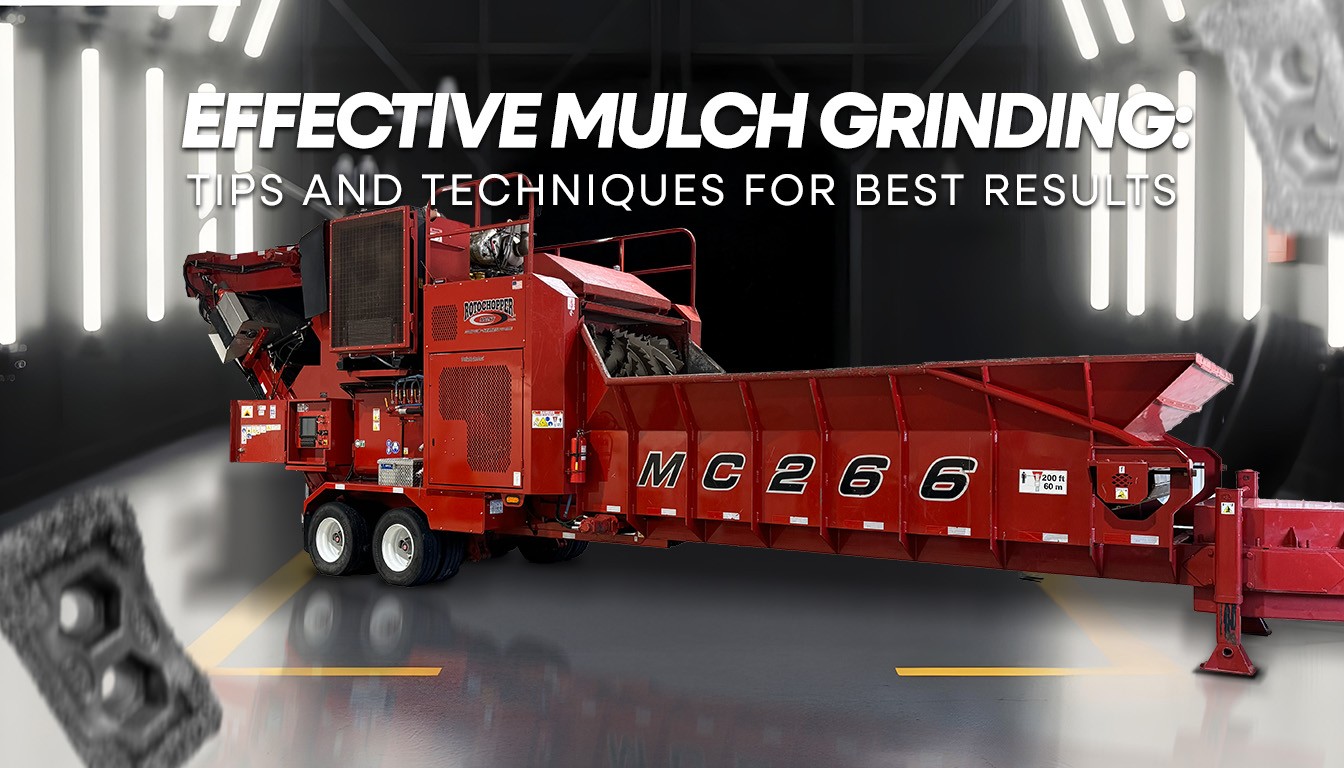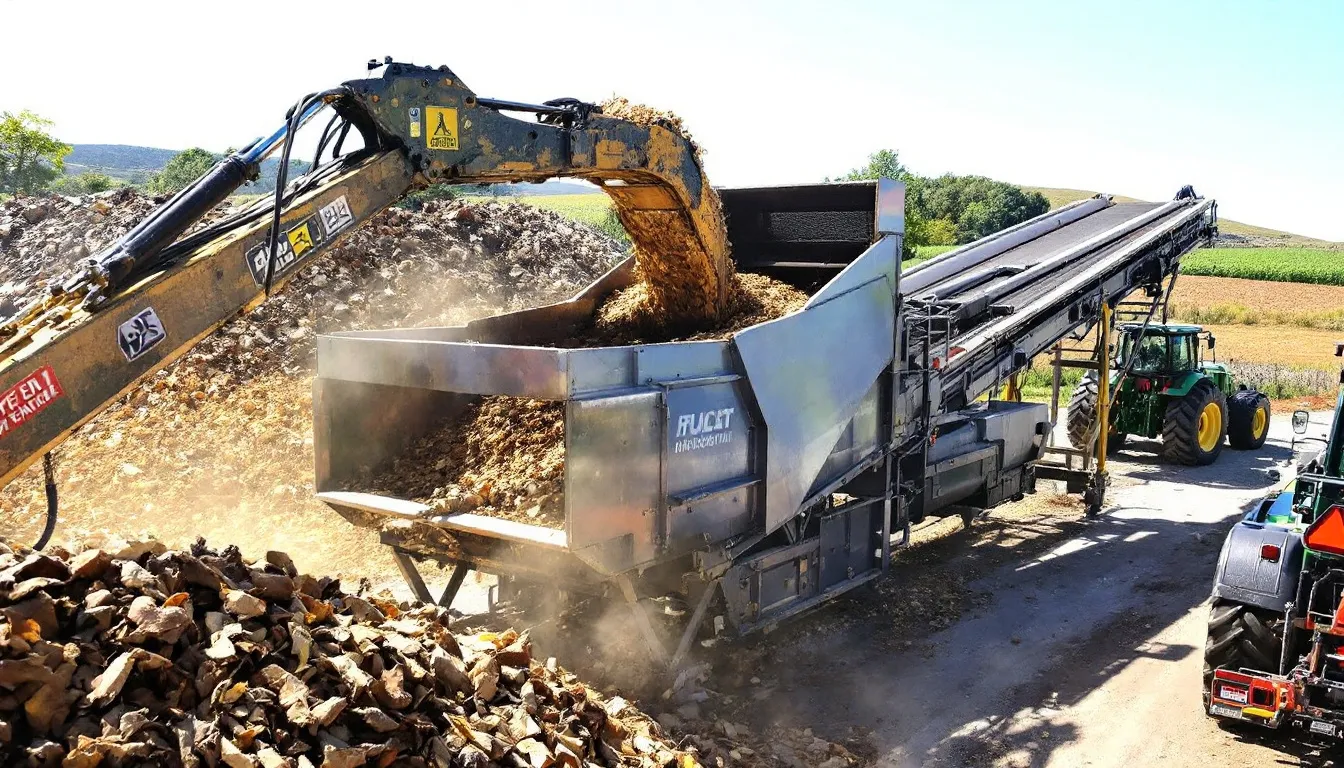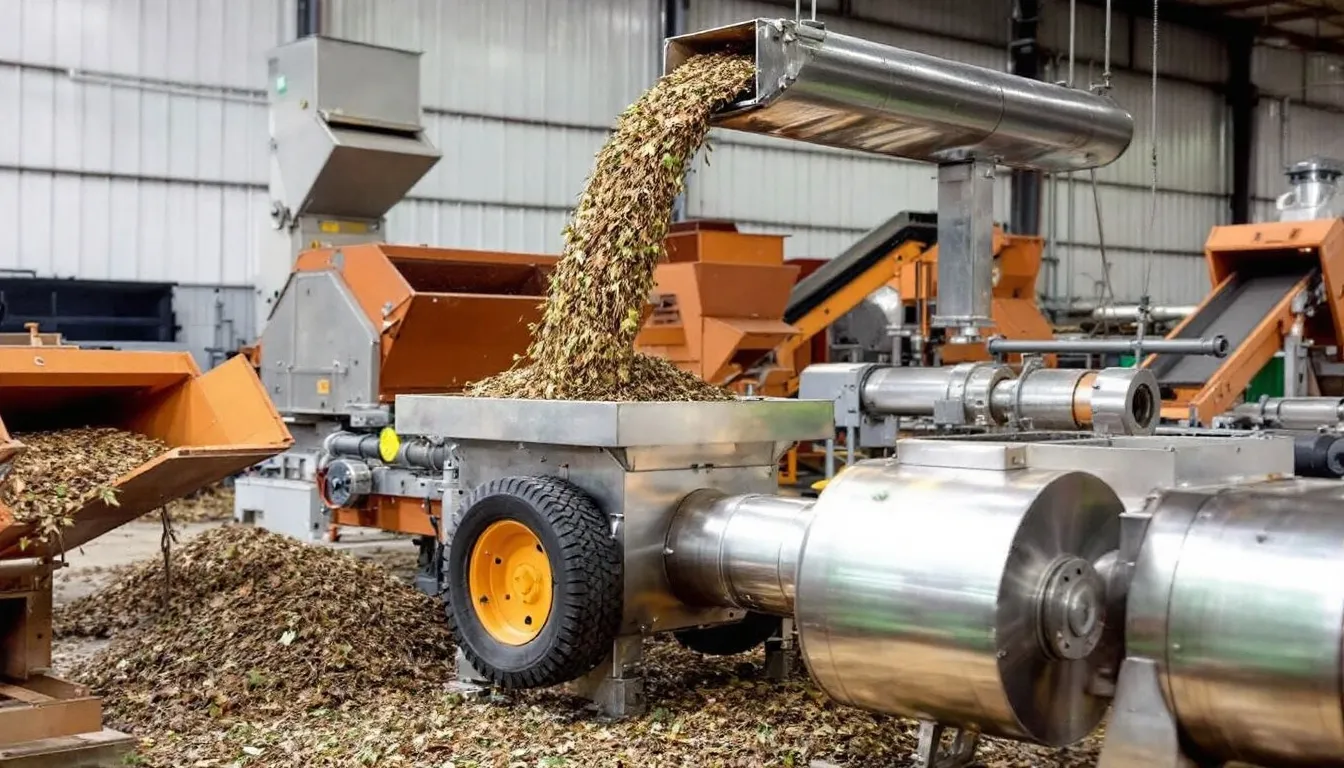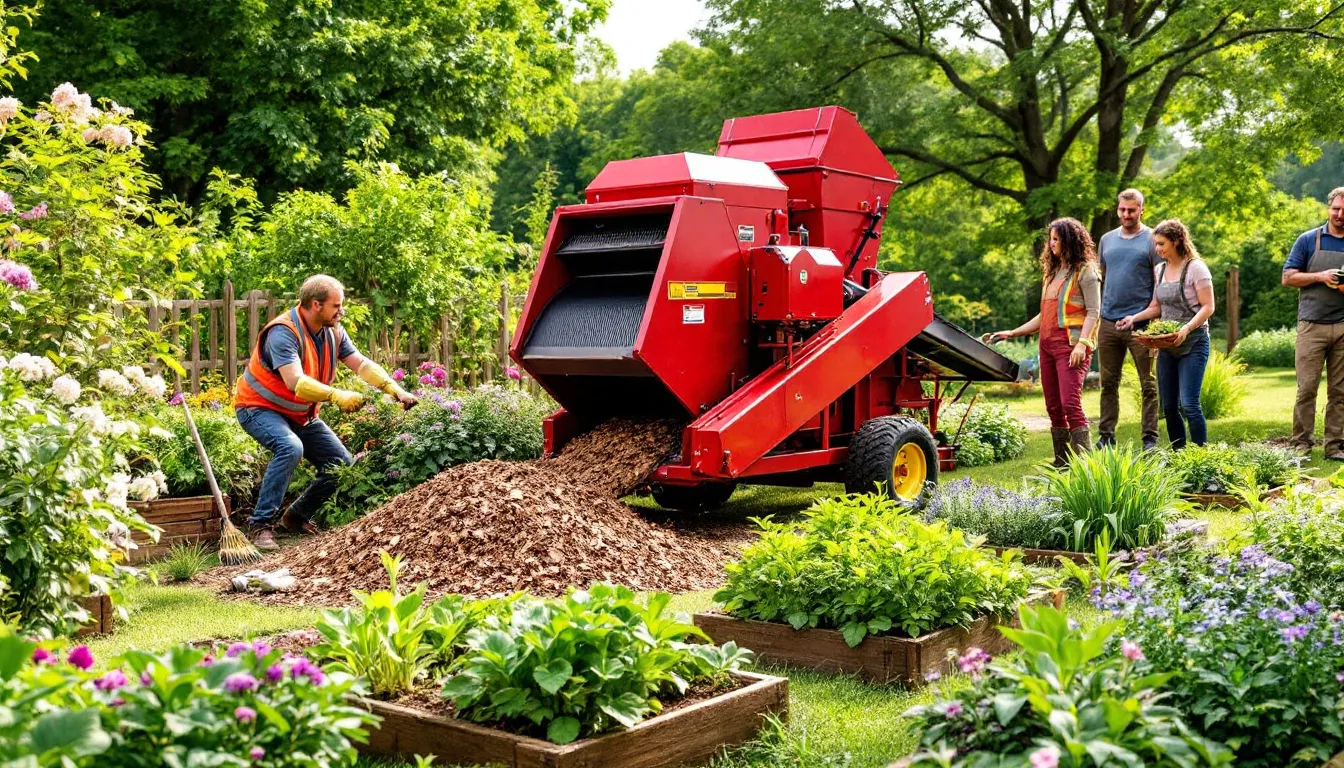Looking to turn wood waste into valuable mulch? Mulch grinding is the key. This article covers the essentials of mulch grinding, from the right equipment and techniques to important factors like moisture content. Get practical tips to optimize your operations whether you’re a large-scale producer or gardening at home.
For more information or samples, please contact us.
Key Takeaways
- Mulch grinding transforms wood waste into valuable products, emphasizing the need for the right equipment, moisture management, and maintenance for quality output.
- Selecting an appropriate grinder type and size, along with the right fiber type, is essential for efficient processing, cost-effectiveness, and creating a product that meets customer expectations in mulch production.
- Maintaining optimal moisture content and screen sizes significantly affects grinding efficiency, product consistency, and the aesthetic and functional quality of the mulch.
Introduction to Mulch Grinding
Mulch grinding is a crucial process in the production of high-quality mulch, transforming wood fiber into a uniform texture and size suitable for various applications, including landscaping and gardening. Mulch producers rely on specialized equipment, such as grinders and screens, to achieve the desired consistency and quality. The type of wood fiber used plays a significant role in the final product, with some fibers being more suitable for grinding than others.
One of the key factors in mulch grinding is moisture content. Proper moisture levels ensure efficient grinding and prevent issues like clumping or excessive dust. Maintaining the right moisture balance is essential for producing a consistent product that meets customer demands. Additionally, regular equipment maintenance is vital to ensure optimal performance and longevity of the machinery.
The cost of mulch grinding can vary based on several factors, including the type of equipment used, labor costs, and the price of raw materials. Efficient grinding operations can help reduce these costs and improve profitability for mulch producers. By focusing on factors such as moisture content, fiber type, and equipment maintenance, producers can create high-quality mulch that meets market demands and enhances garden and yard aesthetics.

Understanding Mulch Grinding
 The primary function of grinding in mulch production is to convert wood fiber into usable mulch, a process integral to both large-scale mulch producers and residential gardeners alike. Grinding not only transforms tree debris into valuable landscape products but also optimizes the mulch’s texture and usability, making it more effective for various applications.
The primary function of grinding in mulch production is to convert wood fiber into usable mulch, a process integral to both large-scale mulch producers and residential gardeners alike. Grinding not only transforms tree debris into valuable landscape products but also optimizes the mulch’s texture and usability, making it more effective for various applications.
At Sylvester Custom Grinding, we pride ourselves on our 25 years of experience in the industry. Specializing in grinding tree debris, we produce a range of high-quality landscape products, showcasing the importance of expert grinding in mulch production today. Utilizing industrial grinders designed to handle various types of wood waste, we ensure that each batch of mulch meets the highest standards of quality and consistency. The ability to handle various feedstocks, such as pallets and round wood, enhances the versatility of our grinding operations, allowing us to diversify business opportunities while simplifying the process.
Understanding mulch grinding’s significance extends beyond the initial grind. It involves a comprehensive approach that includes selecting the right equipment, maintaining optimal moisture levels, and ensuring proper maintenance. Each of these aspects contributes to the overall efficiency and quality of the mulch produced, setting the foundation for a successful grinding operation.
Choosing the Right Grinder
 Selecting the right grinder is crucial for optimizing your grinding operation. The type and volume of material you need to process will dictate the machine’s specifications and size. Horizontal grinders, for instance, excel at handling long materials like logs and branches due to their efficient feeding system, while tub grinders are better suited for bulkier items like pallets and stumps.
Selecting the right grinder is crucial for optimizing your grinding operation. The type and volume of material you need to process will dictate the machine’s specifications and size. Horizontal grinders, for instance, excel at handling long materials like logs and branches due to their efficient feeding system, while tub grinders are better suited for bulkier items like pallets and stumps.
Grinder size should correspond to your processing needs. Larger grinders can handle more material but may incur higher costs if oversized for your operation. It’s essential to balance the grinder’s capacity with your actual requirements to avoid unnecessary expenses while ensuring efficient processing.
Partnering with a reputable equipment dealer provides ongoing support, parts availability, and expert guidance in selecting the best business grinder for your customers’ needs. Such a partnership ensures efficient and productive grinding operations, reducing downtime and enhancing overall performance.
Grinding Techniques and Strategies
Optimizing mulch grinding operations involves employing various techniques and strategies to achieve the best results. One effective approach is to use a combination of grinding and screening to produce a uniform texture and size. This method ensures that the mulch meets the desired specifications and is suitable for its intended use.
Different types of grinders, such as horizontal and vertical grinders, can be used depending on the type of wood fiber being processed. Horizontal grinders are ideal for handling long materials like logs and branches, while vertical grinders are better suited for bulkier items like pallets and stumps. The use of precision grinding equipment can significantly reduce costs and improve the quality of the mulch.
Regular equipment maintenance and operator training are essential strategies for optimizing grinding operations. Well-maintained equipment operates more efficiently and has a longer lifespan, while trained operators can maximize the machine’s capabilities. Additionally, the use of technology, such as remote monitoring systems, can help mulch producers track performance and identify areas for improvement.
When selecting grinding techniques and strategies, mulch producers must consider factors such as energy costs, labor costs, and raw material costs. By optimizing their grinding operations, producers can improve the quality of their products, reduce costs, and enhance overall profitability.
Importance of Moisture Content
Moisture content is crucial in the mulch grinding process. When selecting fiber, consider its moisture content, decomposition level, and suitability for customer needs. High moisture levels can complicate the grinding process, leading to clumping and inefficiency, while low moisture content can result in dust and poor texture.
More decomposed fiber tends to clump together, making the grinding process more challenging. The right moisture balance in the fiber enhances grinding precision, improves mulch quality, and minimizes energy consumption. This balance is crucial for producing a consistent, high-quality product that meets customer expectations.
Mulch producers must account for various expenses beyond just color prices, such as fiber prices and screening costs. Effective moisture content management optimizes the grinding process, reduces costs, and produces a superior end product that enhances garden and yard aesthetics.
Screen Sizes and Their Impact
The shape and size of grinder screen holes significantly influence the efficiency and quality of the end product. Different types of material, such as hardwoods versus soft, wet materials, require different screen configurations for optimal grinding. Selecting the appropriate screen size is crucial for achieving the desired mulch texture and consistency.
A snag baffle screen helps maintain size consistency, especially when the initial grind uses larger openings. This ensures the final product meets market standards and customer expectations. Experimenting with different screen sizes can enhance output without compromising product consistency, allowing for greater flexibility in mulch production.
Screen size selection is part art, part science. By understanding the impact of screens on your grinding operation over time, you can fine-tune the process to produce great mulch that is not only aesthetically pleasing but also functionally effective for soil and plant health.
Maintenance for Optimal Performance
Maintaining your grinding equipment is essential for ensuring its longevity and efficiency. Regular inspections help detect and address potential issues before they escalate. Seasonal checks, especially before and after heavy use, maintain equipment efficiency and prevent unexpected breakdowns.
Wear and tear on grinder blades can significantly reduce efficiency. Regular maintenance and timely blade replacement are necessary for optimal performance. Broken teeth on grinders should be replaced promptly to prevent added stress on the machinery. Proper lubrication of grinding equipment prevents operational failures and extends the machine’s lifespan.
For major issues with the engine or electrical systems, seek professional assistance for repairs. Green waste fiber tends to retain more moisture compared to hardwood or construction waste, leading to increased wear on grinding machines. Proactively addressing maintenance needs ensures smooth operation, reduces downtime, and enhances productivity.
Safety and Regulations
Safety is paramount in mulch grinding operations, as the process involves heavy machinery and potentially hazardous materials. Adhering to safety regulations and standards is essential to protect workers and ensure a smooth operation. Mulch producers must stay informed about industry regulations and implement best practices to maintain a safe working environment.
Key safety measures include regular equipment inspections, proper training for operators, and the use of personal protective equipment (PPE). Ensuring that all machinery is in good working condition and that operators are well-trained can significantly reduce the risk of accidents and injuries. Additionally, maintaining a clean and organized work area helps prevent hazards and promotes efficiency.
Compliance with safety regulations not only protects workers but also enhances the overall efficiency of the grinding operation. By prioritizing safety, mulch producers can reduce downtime, avoid costly fines, and create a more productive work environment. Implementing robust safety protocols and staying up-to-date with industry standards are essential steps in achieving a successful and sustainable mulch grinding operation.
Cost Calculation in Mulch Production
Cost considerations in mulch production go beyond the initial price of the grinder. Fuel efficiency, maintenance requirements, and durability significantly impact long-term expenses. A consistent mulch size, typically 2-1/2 inches, is crucial for marketability and pricing.
Tools like the Coloring Cost-Per-Cubic-Yard Calculator help mulch producers capture all relevant data to improve profitability by analyzing various costs. The grinding process can significantly impact costs, as producing mulch in a single grind may be more economical than multiple grinding processes.
Careful cost calculate and optimization of your grinding operation enhance profitability and produce high-quality mulch that meets market demands.
Winterizing Your Grinder
Winterizing your grinder prevents damage and ensures efficiency during colder months. Storing equipment in a sheltered area can help prevent damage from harsh winter elements. Protecting fuel systems to avoid issues like condensation and freezing is also crucial.
Winter-grade oil ensures smoother engine operation in cold conditions, and maintaining appropriate antifreeze levels protects against freezing and equipment damage. Inspecting hydraulic systems for leaks and replacing worn parts with more durable alternatives can prevent breakdowns in freezing temperatures.
Maintaining proper tire pressure and possibly switching to winter variants ensures optimal performance in winter conditions. These steps ensure your grinding equipment remains in top condition, ready to operate efficiently when needed.
Environmental Benefits of Mulch Grinding
 Mulch grinding offers significant environmental benefits by transforming wood waste into usable mulch, improving waste management. Effective grinding processes create eco-friendly by-products, contributing to sustainable practices. By converting wood fiber into mulch, we minimize the need for burning vegetation, which helps reduce air pollution.
Mulch grinding offers significant environmental benefits by transforming wood waste into usable mulch, improving waste management. Effective grinding processes create eco-friendly by-products, contributing to sustainable practices. By converting wood fiber into mulch, we minimize the need for burning vegetation, which helps reduce air pollution.
Additionally, mulch grinding promotes the growth of native flora by suppressing invasive plant species, supporting biodiversity and enhancing the ecosystem. This sustainable approach benefits not only the environment but also the quality and health of the soil and plants.
By adopting effective mulch grinding practices, mulch producers can contribute to environmental sustainability while producing high-quality mulch that enhances garden and yard aesthetics.
Common Challenges and Solutions
Mulch grinding comes with its set of challenges, but practical solutions can help mitigate these issues. One common problem is the clogging of the grinder, which can be mitigated by regularly monitoring the feed rate and adjusting it as necessary. Inconsistent material quality can lead to uneven grinding results; sourcing high-quality feedstock is essential to ensure a smooth operation.
Dust generation is another prevalent challenge during grinding. Using water sprays can help control dust levels effectively. Higher levels of decomposition in fiber can cause clumping, which poses challenges during the grinding and coloring of mulch. Addressing these challenges proactively ensures a smoother, more efficient grinding operation.
Summary
Effective mulch grinding is essential for producing high-quality mulch that improves garden and yard aesthetics. By understanding the importance of selecting the right grinder, maintaining optimal moisture content, and implementing proper maintenance routines, you can enhance your grinding operation’s efficiency and productivity.
Adopting sustainable practices and addressing common challenges can further improve your mulch production process. With these tips and techniques, you are well-equipped to produce superior mulch that meets market demands and supports environmental sustainability.
Frequently Asked Questions
Why is selecting the right grinder so important?
Selecting the right grinder is crucial as it ensures efficient material processing, which lowers costs and enhances the quality of the final product. Prioritizing this choice leads to better operational outcomes.
How does moisture content affect mulch grinding?
Moisture content significantly affects mulch grinding by impacting both efficiency and quality; excessive moisture can lead to clumping, while insufficient moisture may create dust and degrade texture. Thus, achieving the appropriate moisture level is crucial for optimal mulch production.
What are the benefits of using different screen sizes?
Utilizing different screen sizes can enhance output quality by improving the texture and consistency of mulch. This experimentation allows for tailored results that meet specific requirements.
How can I maintain my grinding equipment for optimal performance?
To maintain your grinding equipment for optimal performance, conduct regular inspections, replace blades as needed, and ensure proper lubrication. Additionally, perform seasonal checks and seek professional repairs for significant issues.
What environmental benefits does mulch grinding offer?
Mulch grinding significantly reduces wood waste and minimizes air pollution from burning vegetation, thereby promoting biodiversity and supporting sustainable practices. This process ultimately enhances the health of natural ecosystems.
